
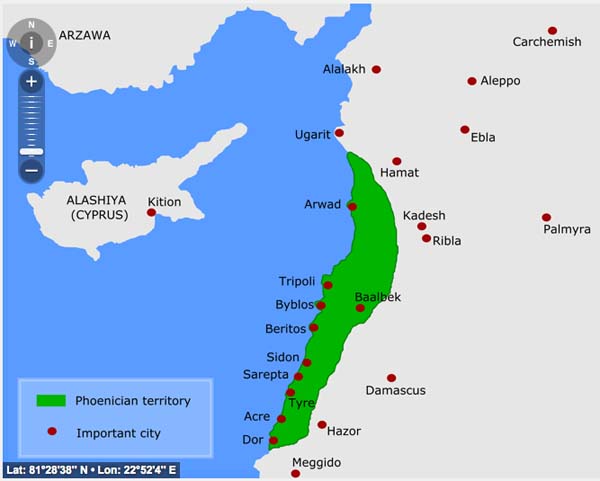


Ancient DNA study finds Phoenician from Carthage had European ancestry PhysOrg - May 25, 2016
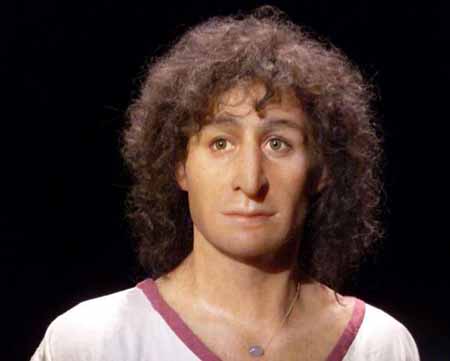
A research team co-led by a scientist at New Zealand's University of Otago has sequenced the first complete mitochondrial genome of a 2500-year-old Phoenician dubbed the "Young Man of Byrsa" or "Ariche". This is the first ancient DNA to be obtained from Phoenician remains and the team's analysis shows that the man belonged to a rare European haplogroup - a genetic group with a common ancestor - that likely links his maternal ancestry to locations somewhere on the North Mediterranean coast, most probably on the Iberian Peninsula.
Phoenicia was an ancient Semitic Canaanite civilization situated on the western, coastal part of the Fertile Crescent. The major Phoenician cities were on the coastline of the Mediterranean. It was an enterprising maritime trading culture that spread across the Mediterranean from 1550 BC to 300 BC. The Phoenicians used the galley, a man-powered sailing vessel, and are credited with the invention of the bireme. They were famed in Classical Greece and Rome as 'traders in purple', referring to their monopoly on the precious purple dye of the Murex snail, used, among other things, for royal clothing, and for their spread of the alphabet (or abjad), upon which all major modern phonetic alphabets are derived.
In the Amarna tablets of the 14th century BC, people from the region called themselves Kenaani or Kinaani (Canaanites), although these letters predate the invasion of the Sea Peoples by over a century.
"Phoenicia" is really a Classical Greek term used to refer to the region of the major Canaanite port towns, and does not correspond exactly to a cultural identity that would have been recognized by the Phoenicians themselves. It is uncertain to what extent the Phoenicians viewed themselves as a single ethnicity. Their civilization was organized in city-states, similar to ancient Greece. However in terms of archaeology, language, life style and religion, there is little to set the Phoenicians apart as markedly different from other Semitic cultures of Canaan. As Canaanites, they were unique in their remarkable seafaring achievements.
Each of their cities was a city-state which was politically an independent unit. They could come into conflict and one city might be dominated by another city-state, although they would collaborate in leagues or alliances. Though ancient boundaries of such city-centered cultures fluctuated, the city of Tyre seems to have been the southernmost. Sarepta (modern day Sarafand) between Sidon and Tyre is the most thoroughly excavated city of the Phoenician homeland.
The Phoenicians were the first state-level society to make extensive use of the alphabet. The Phoenician phonetic alphabet is generally believed to be the ancestor of almost all modern alphabets, although it did not contain any vowels (these were added later by the Greeks). From a traditional linguistic perspective, they spoke Phoenician, a Canaanite dialect. However, due to the very slight differences in language, and the insufficient records of the time, whether Phoenician formed a separate and united dialect, or was merely a superficially defined part of a broader language continuum, is unclear.
Through their maritime trade, the Phoenicians spread the use of the alphabet to North Africa and Europe, where it was adopted by the Greeks, who later passed it on to the Etruscans, who in turn transmitted it to the Romans. In addition to their many inscriptions, the Phoenicians were believed to have left numerous other types of written sources, but most have not survived. Evangelical Preparation by Eusebius of Caesarea quotes extensively from Philo of Byblos and Sanchuniathon.
The Phoenicians of the Iron Age (first millennium B.C.) descended from the original Canaanites who dwelt in the region during the earlier Bronze Age (3000-1200 H.C.), despite classical tradition to the contrary. There is archaeological evidence for a continuous cultural tradition from the Bronze to the Iron Age (1200 -333 s.c.) at the cities of Tyre and Z araphath. In the Amarna age (fourteenth century B.C.) many letters to Egypt emanated from King Rib-Addi of Byblos, King Abi-Milki of Tyre, and King Zimrida of Sidon, and in other New Kingdom Egyptian texts there are references to the cities of Beirut Sidon, Zaraphath, Ushu, Tyre, and Byblos.
Additionally there is a thirteenth-century B.C. letter from the king of Tyre to Ugarit, and a Ugaritic inscription has turned up at Zaraphath. Despite these facts showing that the coastal cities were occupied without interruption or change in population, the term "Phoenician" is now normally applied to them in the Iron Age (beginning about the twelfth century B.C.) onward when the traits that characterize Phoenician culture evolved: long-distance seafaring, trade and colonization, and distinctive elements of their material culture, language, and script.
The Phoenicians, whose lands corresponds to present-day Lebanon and coastal parts of Israel and Syria, probably arrived in the region in about 3000 B.C. They established commercial and religious connections were established with Egypt after about 2613 BC and continued until the end of the Egyptian Old Kingdom and the invasion of Phoenicia by the Amorites (c. 2200 BC).
Other groups invading and periodically controlling Phoenicia included the Hyksos (18th century BC), the Egyptians of the New Kingdom (16th century BC), and the Hittites (14th century BC). Seti I (1290-79 BC) of the New Kingdom reconquered most of Phoenicia, but Ramses III (1187-56 BC) lost it to invaders from Asia Minor and Europe.
The roster of Phoenician cities changed during the near millennium-long period beginning in 1200 B.C., reflecting the waxing and waning of their individual fortunes and the impinging historical events of the Near East. At the beginning of the Iron Age, as part of the invasion of the Sea Peoples (groups from the Greek islands, especially Crete), the Philistines occupied the coastal area south of Mt. Carmel, including Dor, Ashdod, Ashkelon, and Gaza. By the eighth century B.C., however, the material culture of the Phoenicians extended southward, and Sidon controlled Dor and Joppa during the Persian period (539-333 B.C).

The Achaemenians, an Iranian dynasty under the leadership of Cyrus II, conquered the area in 538 B.C. Sidon became a principal coastal city of this empire. The history of Tyre and Sidon is intertwined (indeed they were only twenty-two miles [35 km.] apart). Classical tradition suggests that Sidon was the more powerful at first but by the tenth century B.C. Tyre dominated. Tyre's kings ruled a stretch of the coast that included Sidon and often they were referred to as kings of the Sidonians (1 Kings 16:31).
Fernand Braudel remarked in The Perspective of the World that Phoenicia was an early example of a "world-economy" surrounded by empires. The high point of Phoenician culture and seapower is usually placed ca. 1200-800 BC.
Many of the most important Phoenician settlements had been established long before this: Byblos, Tyre, Sidon, Simyra, Arwad, and Berytus, all appear in the Amarna tablets. Archeology has identified cultural elements of the Phoenician zenith as early as the third millennium BC.
The league of independent city-state ports, with others on the islands and along other coasts of the Mediterranean Sea, was ideally suited for trade between the Levant area, rich in natural resources, and the rest of the ancient world. During the early Iron Age, in around 1200 BC an unknown event occurred, historically associated with the appearance of the Sea Peoples from the north. They weakened and destroyed the Egyptians and the Hittites respectively. In the resulting power vacuum, a number of Phoenician cities rose as significant maritime powers.
The societies rested on three power-bases: the king; the temple and its priests; and councils of elders. Byblos first became the predominant center from where the Phoenicians dominated the Mediterranean and Erythraean (Red) Sea routes. It was here that the first inscription in the Phoenician alphabet was found, on the sarcophagus of Ahiram (ca. 1200 BC). Later, Tyre gained in power. One of its kings, the priest Ithobaal (887Ð856 BC) ruled Phoenicia as far north as Beirut, and part of Cyprus. Carthage was founded in 814 BC under Pygmalion of Tyre (820Ð774 BC). The collection of city-states constituting Phoenicia came to be characterized by outsiders and the Phoenicians as Sidonia or Tyria. Phoenicians and Canaanites alike were called Zidonians or Tyrians, as one Phoenician city came to prominence after another.
Cyrus the Great conquered Phoenicia in 539 BC. The Persians divided Phoenicia into four vassal kingdoms: Sidon, Tyre, Arwad, and Byblos. They prospered, furnishing fleets for the Persian kings. Phoenician influence declined after this. It is likely that much of the Phoenician population migrated to Carthage and other colonies following the Persian conquest. In 350 or 345 BC a rebellion in Sidon led by Tennes was crushed by Artaxerxes III. Its destruction was described by Diodorus Siculus.
Alexander the Great took Tyre in 332 BC after the Siege of Tyre. Alexander was exceptionally harsh to Tyre, executing 2,000 of the leading citizens, but he maintained the king in power. He gained control of the other cities peacefully: the ruler of Aradus submitted; the king of Sidon was overthrown. The rise of Hellenistic Greece gradually ousted the remnants of Phoenicia's former dominance over the Eastern Mediterranean trade routes. Phoenician culture disappeared entirely in the motherland. Carthage continued to flourish in North Africa. It oversaw the mining of iron and precious metals from Iberia, and used its considerable naval power and mercenary armies to protect commercial interests. Rome finally destroyed it in 146 BC, at the end of the Punic Wars.
Following Alexander, the Phoenician homeland was controlled by a succession of Hellenistic rulers: Laomedon (323 BC), Ptolemy I (320), Antigonus II (315), Demetrius (301), and Seleucus (296). Between 286 and 197 BC, Phoenicia (except for Aradus) fell to the Ptolemies of Egypt, who installed the high priests of Astarte as vassal rulers in Sidon (Eshmunazar I, Tabnit, Eshmunazar II).
In 197 BC, Phoenicia along with Syria reverted to the Seleucids. The region became increasingly Hellenized, although Tyre became autonomous in 126 BC, followed by Sidon in 111. Syria, including Phoenicia, were seized by king Tigranes the Great of Armenia from 82 until 69 BC, when he was defeated by Lucullus. In 65 BC Pompey finally incorporated the territory as part of the Roman province of Syria.

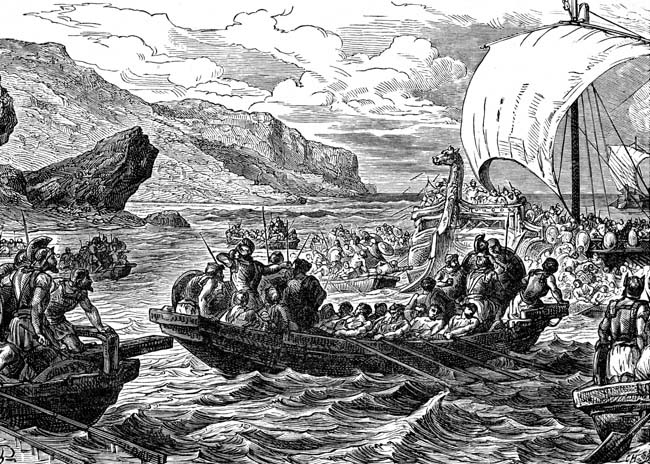 >
>
The Greeks had two names for Phoenician ships: hippoi and galloi. Galloi means tubs and hippoi means horses. These names are readily explained by depictions of Phoenician ships in the palaces of Assyrian kings from the 7th and 8th centuries, as the ships in these images are tub shaped (galloi) and have horse heads on the ends of them (hippoi). It is possible that these hippoi come from Phoenician connections with the Greek god Poseidon.
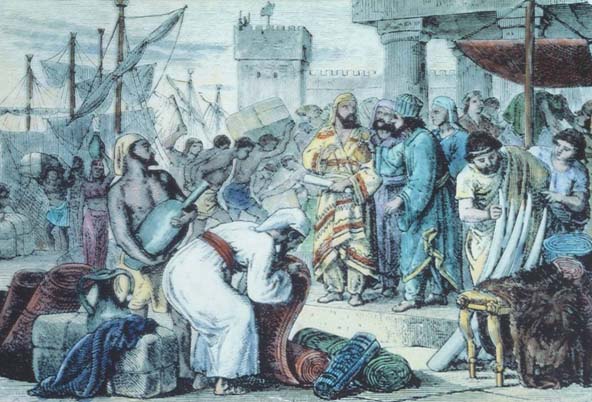
The Phoenicians were among the greatest traders of their time and owed much of their prosperity to trade. At first, they traded mainly with the Greeks, trading wood, slaves, glass and powdered Tyrian purple. Tyrian purple was a violet-purple dye used by the Greek elite to color garments. In fact, the word Phoenician derives from the ancient Greek word phoinios meaning "purple". As trading and colonizing spread over the Mediterranean, Phoenicians and Greeks seemed to have unconsciously split that sea in two: the Phoenicians sailed along and eventually dominating the southern shore, while the Greeks were active along the northern shores. The two cultures clashed rarely, mainly in Sicily, which eventually settled into two spheres of influence, the Phoenician southwest and the Greek northeast.
In the Late Bronze Age (around 1200 BC) there was trade between the Canaanites (early Phoenicians), Egypt, Cyprus, and Greece. In a shipwreck found off of the coast of Turkey, the Ulu Bulurun wreck, Canaanite storage pottery along with pottery from Cyprus and Greece was found. The Phoenicians were famous metalworkers, and by the end of the 8th Century BC, Greek city-states were sending out envoys to the Levant (the eastern Mediterranean) for metal goods.
The height of Phoenician trade was around the 7th and 8th centuries. There is a dispersal of imports (ceramic, stone, and faience) from the Levant that traces a Phoenician commercial channel to the Greek mainland via the central Aegean. Athens shows little evidence of this trade with few eastern imports, but other Greek coastal cities are rich with eastern imports that evidence this trade.
Al Mina is a specific example of the trade that took place between the Greeks and the Phoenicians. It has been theorized that by the 8th century BC, Euboean traders established a commercial enterprise with the Levantine coast and were using Al Mina (in Syria) as a base for this enterprise. There is still some question about the veracity of these claims concerning Al Mina. The Phoenicians even got their name from the Greeks due to their trade. Their most famous trading product was purple dye, the Greek word for which is phoenos.
In the centuries after 1200 BC, the Phoenicians were the major naval and trading power of the region. Phoenician trade was founded on the Tyrian purple dye, a violet-purple dye derived from the shell of the Murex sea-snail, once profusely available in coastal waters of the eastern Mediterranean Sea but exploited to local extinction. James B. Pritchard's excavations at Sarepta in present-day Lebanon revealed crushed Murex shells and pottery containers stained with the dye that was being produced at the site.
From elsewhere, they obtained other materials, perhaps the most important being silver from Iberian Peninsula and tin from Great Britain, the latter of which when smelted with copper (from Cyprus) created the durable metal alloy bronze. Strabo states that there was a highly lucrative Phoenician trade with Britain for tin.
The Phoenicians established commercial outposts throughout the Mediterranean, the most strategically important being Carthage in North Africa, directly across the narrow straits. Ancient Gaelic mythologies attribute a Phoenician/Scythian influx to Ireland by a leader called Fenius Farsa.
Others also sailed south along the coast of Africa. A Carthaginian expedition led by Hanno the Navigator explored and colonized the Atlantic coast of Africa as far as the Gulf of Guinea; and according to Herodotus, a Phoenician expedition sent down the Red Sea by pharaoh Necho II of Egypt (c. 600 BC) even circumnavigated Africa and returned through the Pillars of Hercules after three years. Using gold obtained by expansion of the African coastal trade following the Hanno expedition, Carthage minted gold staters in 350 BC bearing a pattern, in the reverse exergue of the coins, which some have interpreted as a map of the Mediterranean with America shown to the west.
In the Second Millennium BC, the Phoenicians traded with the Somalis. Through the Somali city-states of Mosylon, Opone, Malao, Sarapion, Mundus and Tabae, trade flourished.
From the 10th century BC, their expansive culture established cities and colonies throughout the Mediterranean. Canaanite deities like Baal and Astarte were being worshipped from Cyprus to Sardinia, Malta, Sicily, Spain, Portugal, and most notably at Carthage in modern Tunisia.
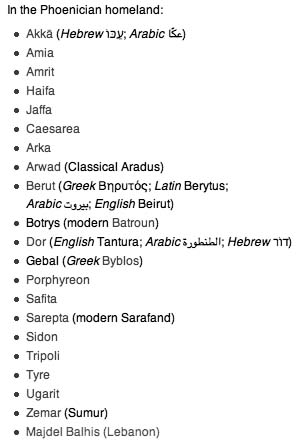
The Phoenician alphabet was one of the first alphabets with a strict and consistent form. It is assumed that it adopted its simplified linear characters from an as-yet unattested early pictorial Semitic alphabet developed some centuries earlier in the southern Levant.
The precursor to the Phoenician alphabet was likely of Egyptian origin as Middle Bronze Age alphabets from the southern Levant resemble Egyptian hieroglyphs, or more specifically an early alphabetic writing system found at Wadi-el-Hol in central Egypt. In addition to being preceded by proto-Canaanite, the Phoenician alphabet was also preceded by an alphabetic script of Mesopotamian origin called Ugaritic. The development of the Phoenician alphabet from the Proto-Canaanite coincided with the rise of the Iron Age in the 11th century BC.
This alphabet has been termed an abjad or a script that contains no vowels. The first two letters aleph and beth gave the name to the alphabet.
The oldest known representation of the Phoenician alphabet is inscribed on the sarcophagus of King Ahiram of Byblos, dating to the 11th century BC at the latest. Phoenician inscriptions are found in Lebanon, Syria, Palestine, Israel, Cyprus and other locations, as late as the early centuries of the Christian Era. The Phoenicians are credited with spreading the Phoenician alphabet throughout the Mediterranean world. Phoenician traders disseminated this writing system along Aegean trade routes, to Crete and Greece. The Greeks adopted the majority of these letters but changed some of them to vowels which were signifiable in their language, giving rise to the first true alphabet.
The Phoenician language is classified in the Canaanite subgroup of Northwest Semitic. Its later descendant in North Africa is termed Punic. In Phoenician colonies around the western Mediterranean, beginning in the 9th century BC, Phoenician evolved into Punic. Punic Phoenician was still spoken in the 5th century AD: St. Augustine, for example, grew up in North Africa and was familiar with the language.
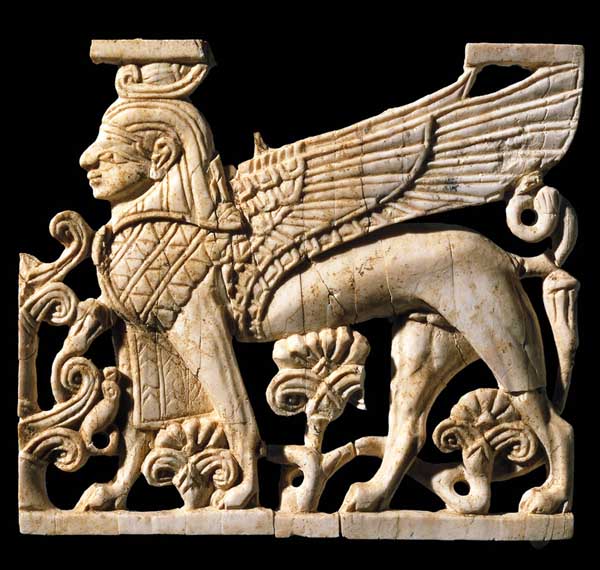
Winged Sphinx - Phoenician, 9th-8th century BC
Found at Fort Shalmaneser, Nimrud (ancient Kalhu), northern Iraq
Phoenician art lacks unique characteristics that might distinguish it from its contemporaries. This is due to its being highly influenced by foreign artistic cultures: primarily Egypt, Greece and Assyria. Phoenicians who were taught on the banks of the Nile and the Euphrates gained a wide artistic experience and finally came to create their own art, which was an amalgam of foreign models and perspectives.

Thousands of Phoenician glass bottles were made to hold oil, wine and other liquids and they were often square-shaped so that they could be packed together conveniently. Glass for ordinary use often had a pleasant blue, green or brown tinge because, although the glassmakers could make clear glass, it was very expensive. One of the oldest glass making techniques ever used was the core-formed method. Molten glass was trailed or gathered around a core of animal dung mixed with clay and supported by a rod. After forming and cooling, the object is removed from the rod and the core scraped out. Core-Formed Blue glass Aryballos, the two handles with marbled turquoise and navy blue feather bands.
Phoenician culture had a huge effect upon the cultures of the Mediterranean basin in the early Iron Age, and had also been affected in reverse. For example, in Phoenicia, the tripartite division between Baal, Mot and Yam seems to have been influenced by the Greek division between Zeus, Hades and Poseidon. Phoenician temples in various Mediterranean ports sacred to Phoenician Melkart, during the classical period, were recognized as sacred to Hercules. Stories like the Rape of Europa, and the coming of Cadmus also draw upon Phoenician influence.
The recovery of the Mediterranean economy after the late Bronze Age collapse, seems to have been largely due to the work of Phoenician traders and merchant princes, who re-established long distance trade between Egypt and Mesopotamia in the 10th century BC. The Ionian revolution was, at least in legend, led by philosophers such as Thales of Miletus or Pythagoras, both of whom had Phoenician fathers. Phoenician motifs are also present in the Orientalizing period of Greek art, and Phoenicians also played a formative role in Etruscan civilization in Tuscany.

A former Phoenician trade post, destroyed and rebuilt by the Byzantines, Sabratah has been classified as a World Heritage Site by Unesco. It is the ruins of one of the largest Roman theatres in the world. Beside this archaeological wonder, you will find sand beaches where you can go for a swim and a new city to discover.